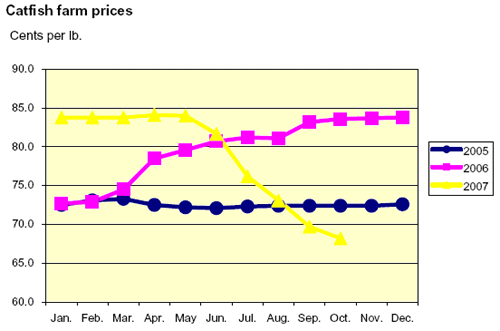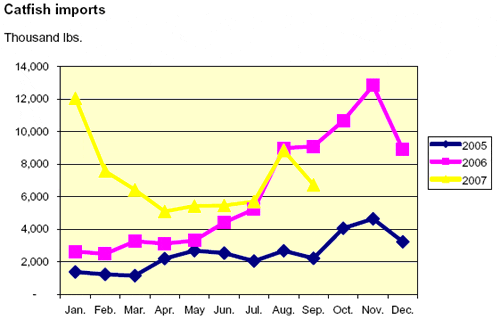Summary
Grower sales of catfish are expected to decline in 2007 for the third consecutive year. In past years the lower sales have been offset by higher prices, but after being strong through the first half of 2007, farm prices have fallen markedly. Grower estimates of inventories in ponds in mid-2007 showed declines in almost all categories, despite relatively strong farm prices in 2006 and the first half of 2007. The lower inventories point strongly towards continued lower sales in the remainder of 2007 and into 2008. Over the first 10 months of 2007, the amount of processed catfish sold was down 12 percent and the average price was basically unchanged.Catfish Farm Sales Down 13 Percent Though October
Catfish sales by farmers to processors are expected to decrease considerably in 2007 to between 495 and 505 million pounds. Based on grower estimates of their inventories at the beginning of July, grower sales are expected to continue lower through the rest of 2007 and into 2008, compared with sales from a year earlier. However, going into 2008, grower sales are expected to be much closer to yearearlier levels than they have been in 2007.
Farm Prices Decline
In both 2005 and 2006, farm sales of catfish to processors were lower than in previous years, but higher per pound prices more than offset the quantity declines. This is not expected to be the case in 2007. Over the first 10 months of 2007, the quantity of farm sales, at 417 million pounds, was down 13 percent from the same period in 2006, and farm prices have averaged 78.8 cents per pound. This is about the same as the previous year, but the average price is expected to decline over the next 2 months as prices have been falling. After averaging 79.6 cents per pound in 2006, farm prices were even stronger through the first half of 2007, averaging 83.5 cents per pound. However, over the last 4 months the farm price for live catfish has declined sharply from 81.7 cents per pound in July to 68.2 cents per pound in October.

Catfish Feed Deliveries Rise
As of July 1, the number of water acres to be used in the second half of 2007 was estimated to be down by 3 percent, and the number of fish that growers reported they had in inventory was down in almost all categories. However, the feed delivery reports tend to point in a different direction. Over the first 10 months of 2007, feed deliveries for food-size fish totaled 788 thousand tons, 12 percent above those for the same period in 2006. With the exception of January and April, monthly feed deliveries have been well above year-earlier levels. The reports for deliveries of fingerlings and broodfish feed would seem to be more in line with the inventory level reported by growers as of July 1. Through October these feed deliveries were down about 17 percent, at 39.5 thousand tons.
Processor Sales Down
Processor sales of catfish products have followed basically the same pattern as those for farm-level sales. Sales of catfish products reached a peak in 2003 at 319 million pounds, and have fallen in 2004, 2005, and 2006 and will most likely decline in 2007. Again like farm sales, in the past when the volume of sales has declined, the weighted average price of catfish products has risen, offsetting the decline in quantity. However in 2007, it is expected that both the quantity and average price for processor sales of catfish will be lower. Over the first 10 months of 2007, the quantity of processor sales is down 12 percent compared with the same period in 2006 and the average price, while up 0.7 percent, has been declining in recent months.
Processor Inventories Also Down
Although farm and processor prices were relatively strong through the first half of 2007, processors had started the year with record high levels of products at 18.7 million pounds. Inventories continued to run considerably higher than the previous year until September. By then, the combination of a large jump in imports and the higher inventory levels had begun to pressure prices downward at both the farm and processor levels. The lower prices have had an effect on inventories, with processors reporting a total inventory of products at the end of October of 12.7 million pounds, down 16 percent when compared with the same period in 2006. If processor inventories remain below year-earlier levels for the rest of 2007, it may allow for some upward movement in prices in the peak demand period in the first quarter of 2008.Catfish Imports Again Higher
Imports of frozen catfish, or fish that can be substituted for catfish, have risen strongly again thus far in 2007. The import estimates reported in the NASS Catfish Processing report totaled 63.4 million pounds over the first 9 months of 2007, up 49 percent from the same period in 2006. However, catfish imports have dropped below their year-earlier levels over the last 2 months. In part, the slowing of imports may be a response to declining prices in the U.S. The imported products in this report include Ictalurus spp., Pangasius spp., and catfish of the order Siluriformes. The majority of the imports so far in 2007 have been Pangasius spp. products. Almost all of these imported products are frozen fillets. The total level of imports compares with 88.5 million pounds of frozen catfish fillets sold by domestic processors in the first 10 months of 2007. In addition to imports of catfish or similar products, there is likely to be some substitution of tilapia products for catfish products, and tilapia imports have increased in 2007, as they have almost continually over the last decade.

Outlook Mixed
The overall outlook for catfish producers and processors for the remainder of 2007 and into 2008 is mixed. On the positive side, imports over the last 2 months have dropped considerably, and processor inventories are finally below year-earlier levels. If these two trends continue, there may be some room for upward price movements in the first part of 2008. Also, with the dollar relatively weak against a number of other currencies, imported fish products will be relatively more expensive. On a less positive note, catfish growers and processors face a number of issues, familiar to all of the livestock industry. Both corn and soybean meal prices are expected to be considerably higher in 2008, so feed costs are expected to go up. In addition, both growers and processors will be faced with higher energy prices. Other major factors that will impact the overall demand for catfish will be imports of competing seafood products and the general health of the domestic economy and its impact on restaurant sales.
Further Reading
|
|
- You can view the full outlook report by clicking here. |
December 2007

